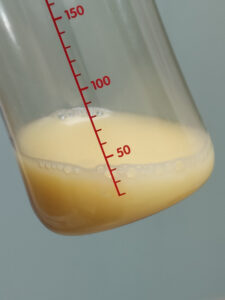Colostrum Milk

Colostrum is the first milk that your breasts produce in the first few days after giving birth. Some mom’s see colostrum leaking before their baby is born, this is normal and her body will still make plenty of colostrum after her baby is born for a few days. Colostrum gives your baby special protection against disease that cannot be obtained from any other source. Formula does not protect against infection in this way. The amount of colostrum is small during the first few days so the baby’s stomach will not be overfilled. This is important while the baby is learning to coordinate sucking, swallowing, and breathing. Baby’s stomachs are very tiny at birth and grow a little larger each day. Mother’s milk production increases gradually every day, matching the baby’s stomach size.
Babies born at full term (at least 37 weeks gestation or three weeks before their “due date”) have extra fluid in their body that can be used for energy production and fluid needs. This extra fluid is used over the first few days while their stomach is too small to accommodate much fluid until mom’s milk supply increases. Frequent small feedings help mom’s milk supply increase quickly in the first days of life.
Extra Fluid Stores
Babies are born with extra fluid stores. This extra fluid is used over the first few days while their stomach is too small to accommodate much fluid. The weight loss babies normally experience in the first few days is simply loss of this “water weight.”
Human Milk
Mother’s own milk should still be baby’s main source of nutrition during your baby’s first and second years of life. Human milk continues to provide immune support throughout breastfeeding.
- Breastfeed prior to each meal of solids, as the “first course.”
- Gradually increase meals, such as: one meal of solids a day at six months, then two solid feedings a day at seven months, three meals a day at eight months, then three meals plus snacks at nine months.
- Breastfeed before each meal and around sleep periods. Important fats found in human milk help build the brain, eyes, and digestive system. The brain and nervous system grow a lot over the first two years of life.
- Breastfeeding offers comfort and emotional support during all the developmental stages of growth.
- As your baby comes into contact with other children, the disease-fighting components of human milk help maintain health.
